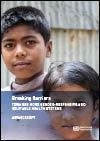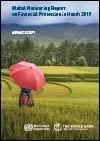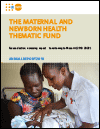What's New
Displaying results 1031 - 1040 of 4913

Resource | Publications,
This Briefing Note outlines Universal Health Coverage (UHC) and the challenges it presents for sex workers and other criminalised populations.
WHO defines UHC as a system where "all people have access to health services they need (prevention, promotion, treatment, rehabilitation and palliative care) without the risk of financial hardship when paying for them". Challenges remain around ensuring adequate financing for UHC, and ensuring a rights-based approach when implementing UHC, so that key populations, including sex workers, are not left behind as a result of criminalisation, stigma and discrimination.

Resource | Publications,
This annual report showcases the many practical ways the APF has made that difference and is helping realise our vision for Asia Pacific where everyone is ‘free and equal’ to enjoy their human rights.
Resource | Presentations,
Get an overview of the HIV/AIDS situation in Brunei Darussalam. Browse and view charts and graphs illustrating data on the country's basic socio-demographic indicators, HIV prevalence and epidemiology, risk behaviors, vulnerability and HIV knowledge, HIV expenditures, and national response.

Resource | Publications,
This report draws attention to gender as a powerful determinant of health care access and outcomes. By analysing universal health coverage (UHC) indicators from a gender perspective, including indicators disaggregated by sex, the report exposes how people’s gender intersects with their socioeconomic backgrounds and other aspects of their identities and circumstances to produce health inequities.

Resource | Publications,
For the first time this joint WHO & World Bank report on financial protection establishes global and regional 2015 baselines for an SDG indicator of catastrophic health spending and SDG related indicators of impoverishment and infers from previous trends the challenges to come in protecting people from the financial consequences of paying out of pocket for the health services they need.

Resource | Publications,
The 2030 Sustainable Development Goals emphasize having all people receive the quality health services they need without financial
hardship. Critical to attaining universal health coverage (UHC) is a formal monitoring mechanism to assess progress. This report does just that. It highlights the global coverage of health services and financial protection. It also addresses gender and equity related challenges. And it identifies primary health care as the route to universal health coverage.

Resource | Publications,
This report presents internationally comparable global, regional and country-level estimates and trends for maternal mortality between 2000 and 2017.

Resource | Publications,
This report highlights key results achieved in 2018 in the four intervention areas of the Maternal and Newborn Health Thematic Fund: midwifery, emergency obstetric and newborn care, maternal and perinatal death.

Resource | Publications,
Are we on track to achieve Goal 5? On 24 and 25 September 2019, Heads of State and Government gathered at UN Headquarters in New York to comprehensively review progress on the implementation of the 2030 Agenda for Sustainable Development and its 17 Sustainable Development Goals. To inform those discussions, UN Women and the UN Department of Economic and Social Affairs have released “Progress on the Sustainable Development Goals: The gender snapshot 2019”. This publication brings together the latest available evidence on gender equality across all 17 Goals, underscoring the progress made as well as the action still needed to accelerate progress.

Resource | Publications,
Sustainable Development Goal (SDG) 3 – ensuring health and well-being for all at all ages – is critical to achieving progress on the 2030 Agenda for Sustainable Development. Because health is an integral part of human capital and a precondition, driver and outcome of sustainable development, SDG 3 is linked to around 50 health-related targets across the SDGs and the pledge to leave no one behind. The overall objective of the Global Action Plan is to enhance collaboration among 12 global organizations engaged in health, development and humanitarian responses to accelerate country progress on the health-related SDG targets. The Plan presents a new approach to strengthening collaboration among and joint action by the organizations, building on an initial joint commitment made in October 2018. The Plan is primarily intended to be strategic but provides some operational detail to guide implementation while also allowing flexibility for adjustment based on regular reviews of progress and learning from experience.





